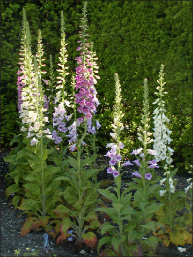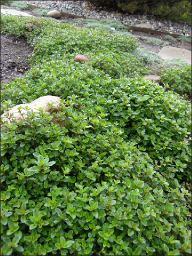
Deer-Resistant Ornamental Plants for Your Garden
A listing of flowers, vines, shrubs and trees that deer prefer not to eat.
Last Updated: 07/19by Cheryl Moore-Gough, Extension Horticulture Specialist
DEER CAN WIPE OUT A GARDEN FASTER THAN
almost any other pest. Two species common in Montana – the white-tailed deer and the mule deer – eat flowers and foliage in summer and browse on tender buds in winter. Even urban gardens are vulnerable to deer damage.

Daffodils, above left, and iris are good bulbs to plant in deer country.
Deer typically feed at night, with a single adult capable of consuming from five to ten pounds of garden plants per night. Utilizing deer resistant plants in the landscape is a good first line of defense. Just remember, no plant is completely deer proof, as a hungry deer will consume almost any plant!
In addition to planting a resistant landscape, you may choose to use one of several different types of repellants. These can be classified according to their mode of action. A combination of different types of products can be more effective than any one method alone, and rotating deterrents is helpful to avoid habituation.
Taste and Scent: These deterrents make the area smell or the plant taste bad. They typically come in granules or sprays, and often must be reapplied after rainfall. Unfortunately, people may also find some odors distasteful! Bad-smelling deterrents include heavily perfumed soap, predator urine, and dried blood or blood meal. The fungicide Thiram not only smells bad, but also tastes bad to deer. Always read and follow label directions, particularly if using a product on plants being grown for human consumption.
Fear Factor: Mechanical and electrical deterrents either frighten or lightly shock deer. These include motion- sensing water and noise devices that are activated by the presence of deer. Wireless deer fencing is available, consisting of electrically-charged posts inserted near the target plant that give off an odor pleasant to the deer. When they touch the posts, they receive a low charge, but frightening shock, that trains them to stay away.
A fence around the garden is a more permanent solution, but it must be at least eight feet high and slant outward from the protected area at a 45-degree angle. You may want to top it with another foot or two of electric fence, but this has the effect of turning a garden into a fortress and is difficult to work pleasingly into the landscape.
A full fence may not be practical in your situation, but smaller barriers may be constructed. Sink stakes and attach netting to surround individual plants. Small plants may be protected with tomato cages or milk crates. Deer are nosy creatures so be sure the holes in the barriers are small enough that those noses can’t reach through.
Deer tend to be put off by the thorny Rugosa rose (but not roses with fewer thorns), and fuzzy or ferny leaves. Also, those plants that could be considered highly scented are not favored. Remember, though, no plant is completely deer proof. A hungry deer will make short work of any plant if it’s hungry enough.

A deer-resistant garden can be beautiful. This garden incorporates Bleeding Hearts, Forget-Me-Nots, Bergenia, Dead Nettle, and Sweet Woodruff for a stunning presentation.
Most of Montana is deer country and you’ll fight a battle you cannot win if you insist on planting species the deer love to eat. While there are some plants that seem to simply delight the palate of a night-feeding deer, like tulips, daylilies, or hostas, any part of a fruit tree, or an unprotected Arborvitae, there are many beautiful plants that deer don’t prefer to eat. There are many ornamental plants that will grow in our state that fall into this category. If you feel this limits a planting scheme, then place plants deer love to eat close to the house and those they don’t prefer farther out in the yard where the animals are more apt to wander. Unfortunately, deer will even come onto front porches. Remember, no plant is safe if the deer are hungry enough.
Following is a list of plants that generally grow well in our state and that deer will usually ignore if their natural food supply is sufficient. Keep in mind, however, that a deer-resistant landscape also depends on the local deer population’s tastes. Species is supplied where it is known, but many references list only the genus. In that case we’ve given the genus followed by “spp.,” the abbreviation for the plural of “species.” Some species of a particular genus will grow under our conditions; some will not. For example, according to the USDA Hardiness Zone rating, Aquilegia canadensis, the American columbine, is a Zone 3 plant and will grow here but Aquilegia bertolonii, the Bertoloni’s Columbine, a Zone 6 plant, won’t. It is recommended to plant only those perennial species that are adapted to your USDA Hardiness Zone.
For additional information, contact your local county Extension office.
Acknowledgements
The author would like to acknowledge the original author of this MontGuide, Bob Gough, former Extension Horticulture Specialist. All photos by Cheryl Moore- Gough.
A Partial List of Deer-Resistant Garden Plants
The following list is separated into ground covers, flowers, vines, shrubs and trees. Each plant is listed with its common name, botanical name, and USDA hardiness zone.
| GROUND COVERS | ||
| Carpet Bugle | (Ajuga reptans) | 4-8 |
| Lily-of-the-Valley | (Convallaria majalis) | 2-7 |
| Dead Nettle | (Lamium spp.) | 3-8 |
| Pachysandra | (Pachysandra terminalis) | 5-9 |
| Periwinkle | (Vinca minor) | 4-8 |
| Sweet Woodruff | (Galium odoratum) | 4-8 |
| Thyme* | (Thymus spp.) | 4-8 |
| FLOWERS | ||
| Astilbe | (Astilbe spp.) | 4-9 |
| Bleeding Heart | (Dicentra spp.) | 3-9 |
| Candytuft | (Iberis spp.) | 3-9 |
| Columbine | (Aquilegia spp.) | 3-9 |
| Coneflower | (Rudbeckia spp.) | 4-10 |
| Daffodil | (Narcissus spp.) | 4-8 |
| Epimedium | (Epimedium spp.) | 4-8 |
| Forget-Me-Not | (Myosotis spp.) | 3-8 |
| Foxglove* | (Digitalis spp.) | 3-8 |
| Goldenrod | (Solidago spp.) | 2-8 |
| Heartleaf Bergenia | (Bergenia spp.) | 4-10 |
| Hellebore | (Helleborus orientalis.) | 4-9 |
| Iris | (Iris spp.) | 3-10 |
| Joe Pye Weed | (Eutrochium purpureum) | 4-9 |
| Lavender | (Lavandula spp.) | 5-9 |
| Lilac Cranesbill | (Geranium spp.) | 4-8 |
| Lungwort | (Pulmonaria spp.) | 3-8 |
| Pinks | (Dianthus spp.) | 3-9 |
| Purple Coneflower | (Echinacea spp.) | 3-8 |
| Rose Campion | (Silene coronaria) | 4-8 |
| Speedwell | (Veronica spp.) | 3-8 |
| Spiderwort | (Tradescantia spp.) | 4-9 |
| Spike Gayfeather or Blazing Star | (Liatris spicata) | 3-9 |
| Sunflower | (Helianthus spp.) | 4-8 |
| Tickseed | (Coreopsis spp.) | 4-9 |
| Yarrow | (Achillea spp.) | 3-8 |
| Yucca* | (Yucca spp.) | 4-10 |
| VINES | ||
| Baltic Ivy | (Hedera helix ‘Baltica’) | 5-9 |
| Bittersweet | (Celastrus spp.) | 3-8 |
| Clematis* | (Clematis spp.) | 3-8 |
| Honeysuckle | (Lonicera spp.) | 4-8 |
| SHRUBS | ||
| American Plum | (Prunus americana) | 3-8 |
| Andorra Juniper | (Juniperus horizontalis ‘Plumosa Compacta’) | 4-9 |
| Beautybush | (Kolkwitzia amabilis) | 4-8 |
| Chinese Juniper | (Juniperus chinensis) | 4-9 |
| Common Buckthorn | (Rhamnus cathartica) | 2-7 |
| Dwarf Russian Almond | (Prunus tenella) | 2-6 |
| Fragrant Sumac | (Rhus trilobata) | 3-6 |
| Globe Caragana | (Caragana frutex ‘Globosa’) | 2-3 |
| Hetz Juniper | (Juniperus chinensis ‘Hetzii’) | 4-9 |
| Honeysuckle | (Lonicera spp.) | 3-8 |
| Japanese Barberry | (Berberis thunbergii) | 4-8 |
| Korean Barberry | (Berberis koreana) | 4-7 |
| Lead Plant | (Amorpha canescens) | 2-6 |
| Lividus Creeping Juniper | (Juniperus horizontalis ‘Lividus’) | 4-9 |
| Lorbergii Caragana | (Caragana arborescens ‘Lorbergii’) | 2-7 |
| Maximowicz Peashrub | (Caragana erinacea) | 2 |
| Memorial Rose | (Rosa wichuraiana) | 5-8 |
| Mockorange | (Philadelphus spp.) | 3-8 |
| Pygmy Caragana | (Caragana pygmaea) | 4 |
| Red Osier Dogwood | (Cornus sericea) | 2-7 |
| Rugosa Rose | (Rosa rugosa) | 2-7 |
| Russian Caragana | (Caragana frutex) | 2-3 |
| Siberian Salt Tree | (Halimodendron halodendron) | 2 |
| Silver Buffaloberry | (Sheperdia argentea) | 2-6 |
| Silverberry | (Elaeagnus commutata) | 3-6 |
|
Sutherland Caragana |
(Caragana arborescens ‘Sutherland’) | 2-7 |
|
Vase Common Juniper |
(Juniperus communis ‘Blue Vase’) | 3-9 |
|
Virginia Rose |
(Rosa virginiana) | 3-7 |
|
Von Ehron Savin Juniper |
(Juniperus sabina ‘Von Ehron’) | 3-7 |
|
TREES |
||
| Austrian Pine | (Pinus nigra) | 4-7 |
| Colorado Blue Spruce | (Picea pungens) | 2-7 |
| European White Birch | (Betula pendula) | 2-6 |
| Hawthorn* | (Crataegus spp.) | 3-6 |
| Honeylocust* | (Gleditsia triacanthos) | 3-9 |
| Mugo Pine | (Pinus mugo) | 3-7 |
| Norway Maple | (Acer platanoides) | 4-7 |
| Norway Spruce | (Picea abies) | 2-7 |
| Paper Birch | (Betula papyrifera) | 2-6 |
| Scotch Pine | (Pinus sylvestris) | 2-7 |
| Silver Maple | (Acer saccharinum) | 3-9 |
| White Spruce | (Picea glauca) | 2-6 |
A Selection of Deer-Resistant Plants



Yucca Clematis Hawthorn



Honeylocust Foxglove Thyme

